|
The
Szeklers’ Land
The Szeklers’ origin is disputed.
The chronicle of a Byzantian emperor, – "Purple-born Constantine"
–, suggests them as a people apart from the Hungarians, eventually
descendants of the Khazars. As the son of Attila held court in the town
of Székelyudvárhely ("Szekler’s courtplace")
some people have raised the theory that they are descendants of the
Huns. The Romanian historiography maintains that they are Hungarized
Romanians or Turkic people.
|
The Szeklers are renowned in
both Romania and Hungary for their skills in working the wood.
One of the specialities of the Szeklers’ architecture are
the gates of the courtyards, the "Szeklers’ Gates".
|
|
The Szeklers themselves are convinced that
they are Hungarians who have preserved their national identity more
purely than the Hungarians living in nowadays Hungary. Even before the
Szeklers’ Land came to form part of Romania the Hungarians from
outside their territory were referred to as "the Hungarians"
with a certain disdain and distrust. In the Transylvanian Diet they
had an own representation, apart from the one of the Hungarians.
The Szeklers have preserved a "notched
script" from the times they arrived in the Carpathians. (It may
be called Runic for its resemblace to the Nordic Runes, but all sources
I found agree that there is no relation between the two.) Allegedly
in Hungary proper a similiar script existed but when the first Hungarian
king, Stephen, introduced the Latin script the former was forbidden
and only was preserved in the Szeklers’ lands. So we know that
the Szeklers came to the place they chose as their home as literate
people. For the (other?) Hungarians this is less certain.
|
|
|
I have modified the order of the letters,
adjusting it to our habits. The "notch script" originally
was read from the right to the left.
|
The Szeklers were given special privileges
by the early Hungarian leaders and kings to perform the task given to
them: to defend the Hungarian territory against other invaders from
the East. These "privileges" were perhaps merely the codification
of their own laws and customs that the Hungarian leaders could not or
didn’t want to dispute at the early stage of settlement. Besides
these rights they had also the obligation to send soldiers whenever
the Hungarian king of the Voivode of Transylvania would demand it.
| The valley of the river Maros near the town of
Maroshévíz (Topliţa) |
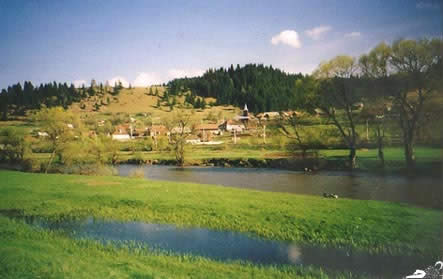 |
A characteristic feature of the Szeklers’
social organization is the prevalence of public property. The woods
and pastures were held in common, the shepherds took care of the whole
village’s cattle, sheep, and so on. Many of these features still
persist today.
Also, among the the Szeklers the women
had similiar rights in holding property as the men, and the sexes were
treated equally in questions of inheritance – perhaps something
they preserved from the times of their migrations from the eastern steppes.
In order to stress the difficult relations
to their Hungarian "brothers and sisters" once again: In Hungary
a lot of evidence with respect to their origins, their original customs,
faith, skills, knowledge and achievements was destroyed after the ascent
of Saint István (Stephen) to the throne. It is more than probable
that the Szeklers, with their fierce resistance to this modernization,
preserved evidence that has been lost in Hungary itself.
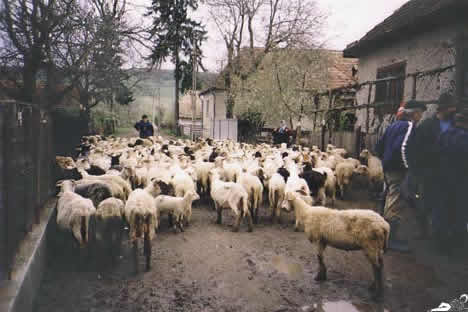 |
On Saint George’s day the village shepherds come to every
peasant and collect the sheep in order to take them to the "estena",
the summer pasture.
Betfalva (Betesţi)
|
When István, the first Hungarian
leader who had himself crowned king, introduced Christianity and serfdom
to his compatriots with considerable violence, he met with the fiercest
resistance among the Szeklers. In a rather remote area between Tusnád
and Kézdivásárhely (Tîrgu Secuiesc) lie the
ruins of a castle called the "castle of the idolaters" which
was the last stronghold of the enemies of István’s reform
package.
| On top of this hill are the rather meagre ruins
that remain from Bálványosvár, the "Idolaters’
castle" |
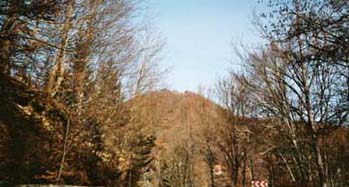 |
The history of the Szeklers from then on
is a history of resistance against serfdom. The Hungarian rulers and
lords of the land tried to impose it with all means, the Szeklers resisted
and staged rebellion after rebellion.
The leader of the greatest peasant rebellion
of Hungary in 1514 was a Szekler: György Dózsa, from Dálnok
(Dalnic) – in nowadays Kovasna county, or more traditionally: Háromszék,
the "Three Chairs". He was an officer from the Turkish wars,
and when there was a call for another cruisade against the "infidels"
a lot of peasants gathered together near Pest. Talking to each other
came to the conclusion that their worst enemy wasn’t the Turks’
threat, but their own lords. They chose György Dozsa as their leader
and the peasant revolt they staged became the most fierce and threatening
in Hungarian history. It was crushed, and Dózsa himself was executed
in an extraordinary cruel manner.
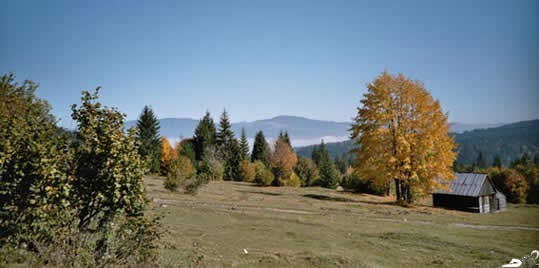 |
The Bucin saddle in the Hargita mountains. |
|
The rather remote village of Varság
(Vărşag) that developed out of the former summer pastures
of Székelyudvárhely (Odorheiu Secuiesc).
|
|
| |
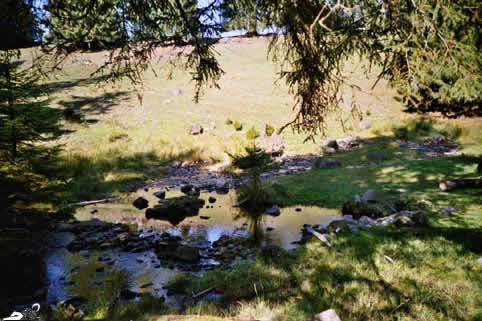 |
Note the yellow, sand-like hills at the right of the above
picture: They are heaps of wood shavings, produced in great quantities
by the carpenters and cabinet makers of Varság, difficult
to get rid of.
A brook in Varság
|
(Only as an appendix: the Hungarian nobles
were then so busy in crushing the peasants’ revolt, in making sure
those serfs would be deprived of any possibility to rise again against
their masters that they had no other thing in mind than ensuring their
dominion upon their serfs, and codifying it. Immediately after their
victory in the peasants’ revolt the "Tripartitum" or
"Book of three parts" was edited, for centuries saving the
Hungarian nobles’ rights against the serfs. Only 12 years later
the Hungarian Kingdom was destroyed by the Turks, as the Hungarian nobles
among themselves weren’t united, and didn’t support the last
Hungarian king – Lajos, killed at Mohács – properly.)
So, as can be stated, there was unity against
their subjects, but no unity against threats from other, alien powers.
The Hungarian subject, or serf, was a more serious enemy to the Hungarian
noble, than the Ottoman Janissary and Spahi ...)
| Fog like this is quite frequent in the basins of
Csík and Gyergyó, due to the waters of the rivers
Maros and Olt crossing them. |
|
The Szeklers were renown fighters and so
the Hungarian, Transylvanian and Habsburg rulers always followed a similiar
policy: Whenever they needed an army they promised to the Szeklers to
grant them their old privileges again and to free them from serfdom.
Once the Szeklers had fought for them and the war had been won, they
were denied their rights. So they revolted, and their revolt was crushed.
So did it happen in the "Bloody Carnival"
of 1596, and these revolts and repressions went on through the whole
17th century, and did not cease after Transylvania was incorporated
into the Austrian Empire with the treaty of Szatmár in 1711.
In the first decades of the 18th century
the Austrian authorities decided to make this
area a part of the Frontier Territory which meant that it was placed
under the direct rule of Vienna and the military authority, the Court’s
War Council. When they started to draft the Szeklers forcibly into the
newly established frontier regiments and those protested and refused,
in 1764 Austrian troops entered by night into the village of Madéfalva
(Siculeni) and killed about 200 of its inhabitants. This was the last
big slaughter of Szeklers, and is remembered as the Terror of Madéfalva,
or in latin: Siculicidium. Today there is a monument in the village
remembering these mass killings.
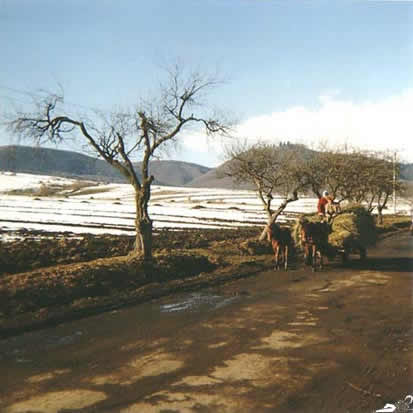 |
As many people keep cattle, sheep or goats, the production
and storage of hay claims an important place in the agricultural
sector. The hay is often stored in the place where it has been
cut, in small wooden cabins, as the farmhouse itself doesn’t
have enough space to store it there.
Also quite common in the Szeklers’ Land is the employment
of horses in transport and agriculture.
|
The persecution they were exposed to, and
their unwillingness to resign to their fate in the course of time prompted
many Szeklers to flee across the ridge of the Carpathians, the border
of Hungary, into Moldavia and settle there. They mixed with the Hungarian
speaking minority in Moldavia, the Csángós, who
nowadays have been rediscovered by Hungarian politicians both in Hungary
and in Romania, and are subject of controversy regarding their numbers,
their national identity, their command of the Hungarian language, and
most of all: their Catholic faith, often the only thing that still distinguishes
them from their Romanian neighbours.
The Catholic church plays a prominent role
in this controversy, trying to fortify its position as a political force,
and gaining territory in the field of education.
These interferences do not really make
the Romanian government happy, and cause a lot of tension also between
ordinary citizens of Romanian ethnicity, with respect to their Hungarian
compatriots.
|
Traffic is an extremely interesting thing in the Szeklers’
Land. It is both amazing to watch what
is being transported, and how it
is done.
This man brings the wreck of a Dacia to a workshop
where another wreck is awaiting it. They were then both cut apart
in the middle and welded together and so an entire Dacia was made
out of the two wrecked ones.
|
|
 |
The wreck, by the way, came by train from another
town, where the workshop had ordered it.
This Dacia car is taking a lot of wool somewhere.
|
During the communist times the Szeklers
for a while enjoyed a certain autonomy, but later they were deprived
of it. Collectivization became very important for the central authorities
in this area, as a tool to further centralization. It wasn’t only
the private land that was especially targetted, but also in a very prominent
place the common grounds of the Szeklers: the pastures and woods.
By collectivizing the pastures they could be taken out of the hands
of the local authorities, and as a part of the collective farms were
placed under the command of a central authority. The woods were nationalized.
So two kinds of public property clashed,
to the detriment of the traditional one.
When someone wanted to keep animals, he
had to cut the grass for them in his spare time, on grounds that were
formerly his own or belonged to the village, and to deliver half or
two thirds of it to the Kolkhose. Only the part that was left to him
he could feed to his cow(s) or sheep. And still, as a friend told me,
then all the grass in the village and on the slopes was cut, not a single
meadow was left fallow – on the contrary to now.
Villages with Romanian population, by the
way, were sometimes spared from collectivization, although their lands
would have offered better conditions for large-scale cultivation than
remote (Hungarian-populated) mountain villages. This has to be mentioned
in order to show that collectivization in Romania often had more political
than economical aims.
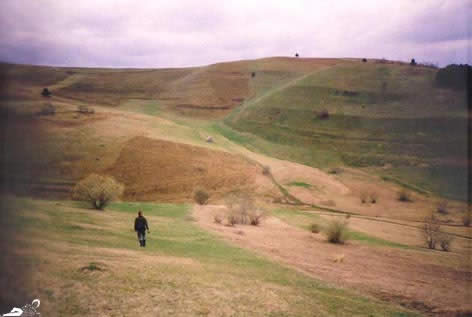 |
Meadows and fields near the town of Ditró
(Ditrău) in the basin of Gyergyó.
All the work here is still done by hand, eventually
with the help of horses, or, more seldom, oxen.
Only in the last years tractors have appeared.
|
|
Fields and a typical carved wooden stele in
Háromszék, near the town of Kézdivásárhely
(Tîrgu Secuiesc).
The softness of the landscape is confusing, it is in contrast
to the harsh climate and living conditions that prevail in the
Szeklers’ Land.
|
|
After 1989 these collectivized lands were
restituted in a complicated process that created a lot of work and good
income for lawyers and judges. In the meantime the lands which had no
owner became a prey for clever and unscrupulous businessmen who exploited
them with almost 100% profit, with no investments.
This affected most of all the nationalized
woods. The woods of the Szeklers’ Land have been exploited to the
utmost for about ten years. Many woods only survived because they were
situated in areas that were extremely difficult to access. The
special lorries that carry the tree trunks, called "remorcas"
(= tow-cars) destroyed the roads.
Only in the last years, after restoring
the common property, the wild destruction of the woods has stopped and
a process of reforestation has started.
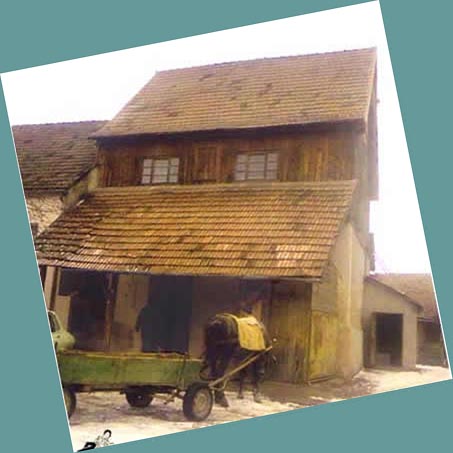 |
A mill in a village near Székelykeresztúr (Cristuru
Secuiesc).
The machines that grind the grain were manufactured in the
time of the Austro-Hungarian Monarchy, that is before World War
I, in the Budapest-based Ganz factory that has vanished only in
the 90-ies, due to the privatization process.
The farmers bring the grain and pay with a part of their harvest,
getting back the remainder as flour. No cash is involved.
|
This uncontrolled exploitation of the woods
didn’t take place only in the Szeklers’ Land, but in all of
Romania, and has been the main cause of the floods that have affected
Romania, Ukraine, Hungary and Serbia during the last ten years.
The Szeklers’ Land is not only the
origin of some of the tributaries of the Tisza and Danube, but also
full of natural springs and mineral water, and a lot of spas. As most
other touristic facilities all over Romania, they fell into decay after
the communist era recreation facilities were deserted, as the organisations
owning them – trade unions, schools, pensioners’ organizations
– dissolved, or were left without funds.
Slowly now private tourism on small scale
is emerging and perhaps such spas as Tusnád, Homorod, Borszék
(Borsec) or Hévíz (Topliţa) will one day again live
up to their former glory and prosperity.
|
Tusnádfürdő (Băile Tuşnad)
in rather inhospitable weather.
The heavy fog left the trees clad in a coat of hoarfrost.
|
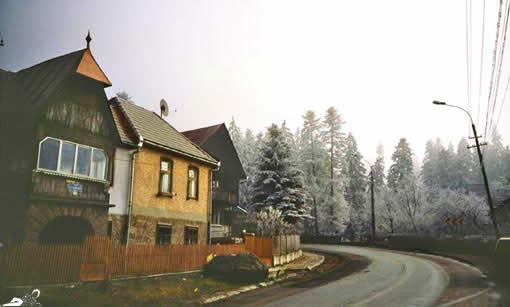 |
After 1989 lots of factories were closed,
and many people were left without jobs. Some of them managed to retire
at an early age. Many people I know go to work in Hungary, mostly illegally,
in construction.
Many of the youngers don’t want to
bother with working abroad (as they have no skills for that) or with
agriculture (for which they have neither energy nor sympathy), they
would like to make quick money with all means. The latest fashion for
good-for-nothings is to join the French Foreign Legion.
Bad perspectives for the future of the
Szeklers’ Land ...
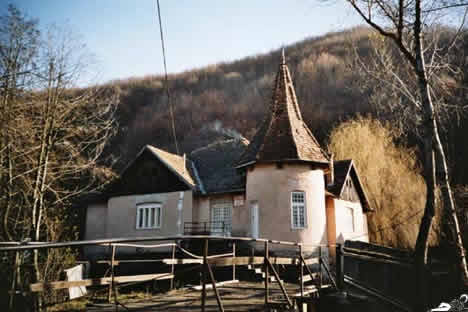 |
Some more specimen of the architecture of
the Szeklers:
A private house in the village of Parajd (Praid) at the foot
of the Hargita mountains.
|
| The castle of Marosvécs (Brîncoveneşti)
in the valley of the Maros, now an insane asylum. |
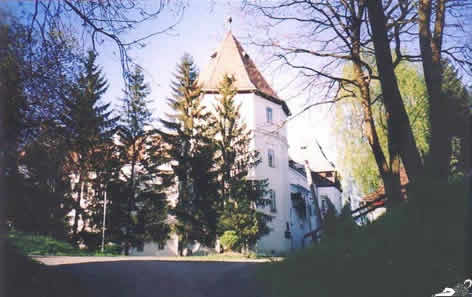 |
The Szeklers’ Land has always been
a country of emigration. People emigrated to Budapest, to Germany, to
the United States, to Canada. Some made a good living there, others
failed.
But as a friend of mine said: as far as
I can judge it, in the end they all come back home to die ...
back to Transylvania
back to main
page |